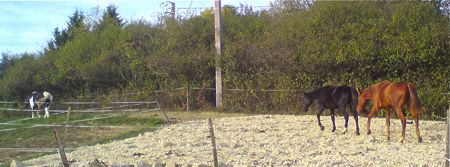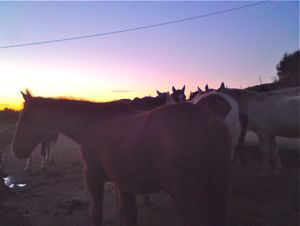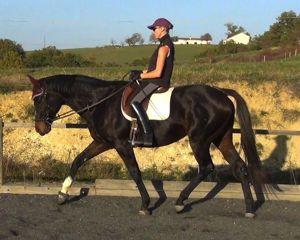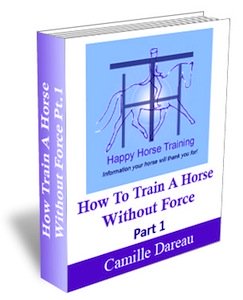| Back to Back Issues Page |
 |
|
The Whole Horse No. 32 - Going Rugless December 03, 2013 |
Going RuglessSpotlight On Management:
Stopping using rugs for our horses has been one of the hardest changes we have made so far, in their interests. Why? Because it didn't feel like withholding the rugs was in their interests. There is no denying that most of us will make decisions for our horses depending as much on how we feel in our own bodies, as on whatever other evidence is available. So when winter draws in, and we start to load on the jumpers and the heavy winter coats, of course it feels right to do that for our horses. This brings up the second trap we fell into: what other evidence is available? Apart from anecdotes and theory, which we no doubt shied away from reading, there is the evidence under our own eyes... and that was telling us that our horses need rugs! The weather is very changeable where we are here in the South West of France. It can be 40ºC (104ºF) in the shade in the summer, and drop to -15ºC (5ºF) in the winter. In the autumn of our first or second year here, it was 19ºC (66ºF) at night, and it would have been crazy to put rugs on them, but one night there was a storm with heavy rain during the night, and afterwards the temperature suddenly dropped to 4ºC (39ºF). The horses were miserable and shivering, and a quite a few of them got a chill. We were annoyed with ourselves that we hadn't put the rugs on. Other times, even with the rugs on, the horses have been desperate to come in the stables - shivering and unhappy - so the very idea of not using them just didn't cross our minds. As we go further and further down the holistic path with our horses, however, we are gaining a better understanding of how living beings work. The concept of 'process' is everything. Both from the training point of view, and the healing/rehabilitation point of view. In fact, for us, the two are very much interdependent, if they are separate at all. Our recent illumination on the subject of process, is that our horses suffered when they were caught out in bad weather without their rugs because they were dependent on their rugs. This dependency meant that we couldn't expect them to suddenly cope without them.
This also explained why they would still become cold even in the rugs, because the rugs were disturbing their metabolism to such an extent that they couldn't respond to sudden temperature drops. Not only that, when their un-rugged parts would get cold, and their natural thermoregulation set about heating them up, their body (under the rug) would get over-heated. Horses' thermoregulation functions throughout their whole body, and cannot distinguish between rugged and un-rugged parts. So what are the results up until now?
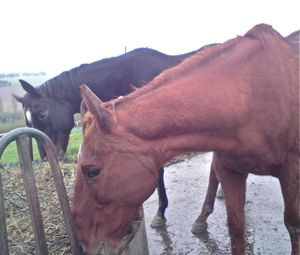
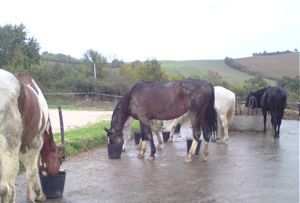
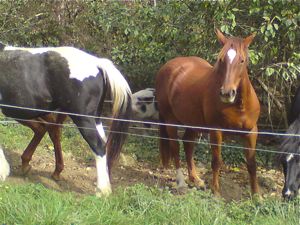
What About the Inconveniences of Not Using Rugs? It has been indicated that horses who are using their own resources to keep warm during cold weather do not have as much energy available to exert themselves physically. Therefore, we should be prepared to reduce their workload during these periods of the year. The importance of this probably depends on the individual horse, and the efficiency of their thermoregulation. Also, it is likely that the more habituated a horse becomes to self-heating, the more energy they will have available for working, but it is something we should be careful to take into account when asking the horse to work in the winter - the best way is to use your intuition to know whether it feels right to work your horse or not. Some people see this as a major disadvantage to keeping horses rugless, but it's just another of those choices we have to make between putting our horses' natural well-being first, or prioritizing our own desires. In our experience, it never does horses any harm at all, in terms of their training progress, to have a good period of time off every year, as long as they are living a natural lifestyle with freedom and social stimulation.
Above: horses encouraged to do their own exercise on a Paddock Paradise system. Our horses have to make a fairly long journey round the lanes between hay and water. The other big disadvantage we always used to use to justify rugging, is the inconvenience of horses getting covered in mud, with the extra grooming time needed if they are to be worked. Where we live, the soil is incredibly sticky clay, which is very difficult to remove when the horses roll. Nonetheless, we haven't found this to be much of a problem since going rugless this year - if anything the horses roll less (probably because they are not hot and itchy all the time), and the rain often washes them off to some extent. The most time-consuming parts to groom are the legs, head and neck, and these are not normally protected by rugs anyway. That being said, some people have toughened themselves up phenomenally through exposure and habituation, so maybe we humans should be going more down that route, rather than dragging horses further towards the fragility and artificial dependency on comfort that we believe is so beneficial!
Parallels with Training
Promoting a dependency on rugs instead of allowing the horse's natural ability to cope with harsh weather to function is very similar to riding in a way that encourages both horse and rider to depend on the reins for balance, instead of using their own inner postural resources. In any aspect of the body (and the mind) whatever we do not stimulate does not develop and remains weak. For example, when metal pins are used to help reconstruct a bone fracture, over time the bone supported by the pins (although it heals) becomes less strong and dense, because the pins are compensating for the weight bearing. This kind of situation can lead us to believe that the support is a necessity, because it has become so. When we have been used to depending on the reins to control the horse and to feel balanced and secure, then it can feel like there is no other way, and whenever we let go, the horse seems to prove this to us - perhaps by hollowing, speeding up, not going where we want him to. 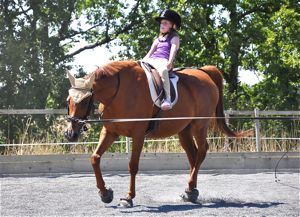 However, if we give ourself and the horse the time to find another way, by letting go of the dependency, then everything can change. It will become possible, indeed necessary, to find a different way of maintaining balance and control within our own posture, and this will give the horse the chance to do the same. The young rider in this photo is being given the opportunity to find her own balance without the reins right from the start!
However, if we give ourself and the horse the time to find another way, by letting go of the dependency, then everything can change. It will become possible, indeed necessary, to find a different way of maintaining balance and control within our own posture, and this will give the horse the chance to do the same. The young rider in this photo is being given the opportunity to find her own balance without the reins right from the start! Obviously, we have to work hard at learning this new skill, and find the right advice to follow, but as soon as the dependency is dropped, the door is open to change and liberation. Keeping horses naturally is to a large extent about liberating them from the constraints of the artificial lifestyle we have become used to imposing on them. Good riding and training is about liberating the horse and rider in motion from the constraints of imbalance and resistance. Both result in fulfillment and joyful experiences. That's what inspires Happy Horse Training!
Odette, an ex-racehorse, who has found a new way of balancing by carrying herself in postural engagement, and no longer seeks out the reins for support Enjoy this newsletter? Click here to share it on Facebook:
See and share topical news, info and photo's on the Happy Horse Training Facebook group. Once you join you can take part in lively, friendly discussion on subjects relevant to holistic equitation, and make contact with like-minded people all over the world.
Just Click here to go to the HHT group page, and then click on the 'join group' button at the top right of the page.
Sharing the Holistic Message
If you enjoy the Happy Horse Training website, and you find the information on it useful, please help us to share it by clicking on the Facebook 'like' and 'share' buttons that are on each page (you can also share this newsletter by clicking on the symbol above). Any other way you can pass the site on to friends and colleagues, for example via discussion forums, is also greatly appreciated. You can also sign up to our RSS feed (blog) to be kept up to date with new ideas, pages and other information that we post there. Just click on the box that says 'subscribe to this site' at the left of each page. The equestrian world is one dominated by traditionalist ideas and conventions, but we would like to help inform the growing minority of horse-owners who want to make their horses happier with progressive and holistic methods.
Happy Horse Training now has over 100 pages exploring many different areas of holistic equitation. Do have a look through our site plan to find the subjects and categories that interest you.
Available from HHT:
New! The Gymnastic Rider eBook 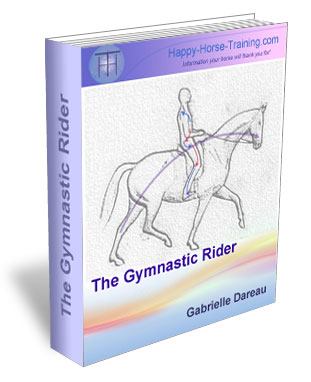 Available exclusively from HHT, a unique and comprehensive guide to practical rider biomechanics. This professionally produced eBook takes the rider through the process of developing their body in the specific way that brings the horse's movement into harmony and balance, without force and constraint.
Available exclusively from HHT, a unique and comprehensive guide to practical rider biomechanics. This professionally produced eBook takes the rider through the process of developing their body in the specific way that brings the horse's movement into harmony and balance, without force and constraint. The information in this book, including over 55 000 words, represents what we would normally pass on in a minimum of 12 specialist lunge lessons, focusing on each part of the position and its influence on the horse, with a value of at least €450. The Gymnastic Rider is available for only €29.99. Click here for full details, and to download the 15-page introduction to the book for free.
How to Train a Horse Without Force eBook With your purchase you will receive a free bonus supplement on Horse Trauma - cutting edge insights on this subject that up until now have mostly been applied only to human trauma. This supplement shows how to recognise, avoid and deal with horse trauma, which is much more common that we realise. These two e-books - How to Train a Horse Without Force and Horse Trauma comprise more than 75 thousand words and are richly illustrated. They are available for only 19.99 Euros (around $26). Click here for more details.
|
| Back to Back Issues Page |
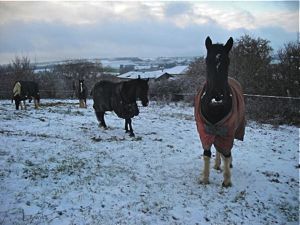
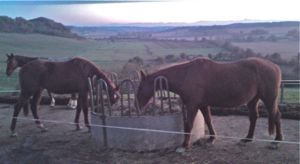 Currently, we have one herd with man-made shelter, and one without. Both herds have access to hay in slow feeder nets during bad weather. The toughening up (rehabilitation) process has been since the end of the winter last year, and has included exceptionally cold and rainy conditions in the spring, the usual baking heat in the summer, followed by persistent rain and temperatures as low as 2ºC (36F), and freezing weather down to -5ºC (23F) so far.
Currently, we have one herd with man-made shelter, and one without. Both herds have access to hay in slow feeder nets during bad weather. The toughening up (rehabilitation) process has been since the end of the winter last year, and has included exceptionally cold and rainy conditions in the spring, the usual baking heat in the summer, followed by persistent rain and temperatures as low as 2ºC (36F), and freezing weather down to -5ºC (23F) so far. 